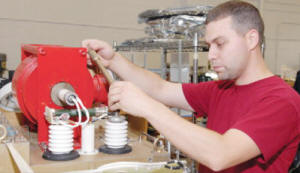Simple Modification Increases ATC Reliability |
|
During a search for information on the AN/MPN-14 mobile radar system like what I worked on in the USAF, I ran across this story printed in the Tobyhanna "Reporter" that describes a modification to a high voltage transformer that increases reliability in humid environments. Unless otherwise marked, U.S. government documents may be freely copied so long as the content is not altered from the original. See the Radar Shop page on RF Cafe. TobyhannaReporter Vol. 53, No. 13 Tobyhanna Army Depot, Tobyhanna, PA (www.tobyhanna.army.mil) July 7, 2009 Simple modification increases ATC reliability by Anthony Ricchiazzi Editor An innovative solution developed and tested by personnel here increases reliability of a critical Air Traffic Control and Landing System (ATCALS).Several AN/MPN-14K Airport Surveillance Radars (ASR) recently stopped operating due to electrical arcing between components in the transmitter vans. An electric arc is basically a continuous discharge of electricity between two points. In this case, the arcing was between the R20 resistor and the cathode on the Magnetron tube and obviously unintentional. Jason Rinehimer installs new brackets on AN/MPN-14K Airport Surveillance Radar transformers that will help eliminate electrical arcing. Rinehimer is an electronics mechanic in the Intelligence, Surveillance and Reconnaissance Directorate's Air Traffic Control Division. (Photo by Tony Medici) There was a marked increase in the numbers of MICAPs for the ASR Transmitters over the past year and something had to be done quickly to get these critical components back into service. “Without this radar, an entire air field can go down, so it is very critical that it be repaired quickly,” said Ngoc Dang, [love that name! - KRB] a senior radio frequency engineer in the Production Engineering Directorate. “Because several systems went down in a short period of time, the Air Force asked us to help find a solution.” Tobyhanna overhauls and repairs ATCALS and individual ATCALS components. Components include radar transmitters, Identification Friend or Foe systems and radios. Work includes a complete electrical overhaul, and mechanical repairs such as structural renovations and painting carried out by the Systems Integration and Support Directorate.“Tobyhanna carries out comprehensive overhaul of the ATCALS systems as well as MICAP (Mission Capability) items. MICAP means it is already a top priority system to repair and send back to the field as soon as possible,” noted Rich Steele, an electronics mechanic leader in the ATCALS Division, Intelligence, Surveillance and Reconnaissance Directorate. “ATCALS has been in service for about 30 years.”
Tobyhanna fabricated these brackets to reduce the incidence of electrical arcing. (Photo by Tony Medici) Dang knew that humidity can cause arcing between components. Humidity inside the radar shelter will quickly increase beyond specified limits if the climate control system is not working normally or due to simple problems such as the shelter door not shutting properly. “I believe that the humidity issue needs to be addressed because the Air National Guard units are still going to see arcing if the shelter doors are inadvertently left open,” said George Salitsky, deputy director for Intelligence, Surveillance and Reconnaissance. “These systems contain very high voltage components and require very low humidity conditions to operate safely and properly. Arcing can still occur if humidity is too high, even with this modification, so the field needs to take humidity factors very seriously.” To provide a temporary solution until a permanent fi x is developed, Dang designed brackets that increase the air gap distance between the components, where the arcing was occurring. The ATCALS Program Office reviewed Dang's designs and provided Tobyhanna with a one-year waiver to continue using this modification on all ASR transmitters while the root cause analysis is in process. “The brackets increase the reliability of the ASR, but it is important that the climate control system work normally as well, because high humidity could still cause arcing, even with the brackets,” Dang explained. The brackets were fabricated by Systems Integration and Support Directorate technicians and installed by ATCALS Division personnel. “After we reinstall the components with the new brackets, we test the system for 72 hours at the Radar Test Site,” Steele said. “It is a work in progress. The brackets increase reliability and we are confident they will do the same in the field. But a permanent solution is still being researched.” Steele noted that depot technicians are also working on a package that allows users in the field to remove the old brackets and install the ones. “This should eliminate the need to send an ASR to us for the same problem, which will save a lot of time in getting a system back online,” he said. Here is the original Tobyhanna Reporter publication. Related Pages on RF Cafe - Introduction to Radar (Air University) - Radar Equation, 2-Way (another) - Radar Techniques - Primer (1945 QST) - RF Cafe Quiz #7 - Radar Principles - EW/Radar Handbook - Doppler Shift - Identification Friend or Foe (IFF) |

